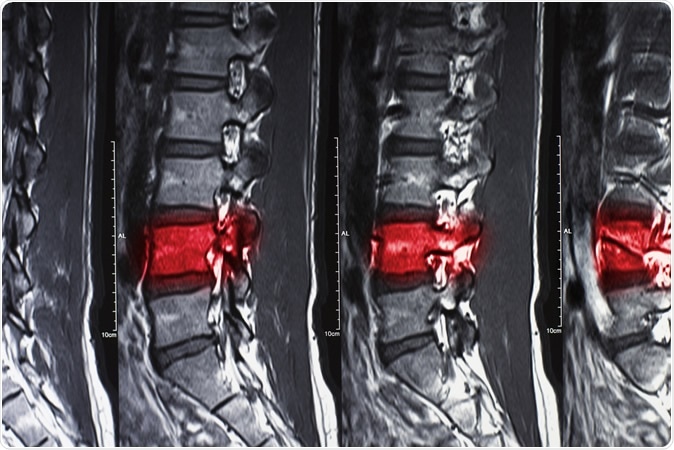Researchers from the University of Michigan used nanopaticles injection to prevent the immune cells of the body from impairing the healing of injured brain and spinal cord. They call this an “EpiPen” or emergency rescue drug for the brain and spinal cord when they suffer trauma.

Magnetic resonance imaging of human show fracture and compress spine. Image Credit: SORANAT7 / Shutterstock
The study titled, “Intravascular innate immune cells reprogrammed via intravenous nanoparticles to promote functional recovery after spinal cord injury,” was published in the latest issue of the Proceedings of the National Academy of Sciences.
 PLG multichannel bridge and hemi-sectional SCI model.
PLG multichannel bridge and hemi-sectional SCI model.
Lonnie Shea, the Steven A. Goldstein Collegiate Professor of Biomedical Engineering, the William and Valerie Hall Chair of Biomedical Engineering and a professor of chemical engineering, lead author of the study said in a statement, “In this work, we demonstrate that instead of overcoming an immune response, we can co-opt the immune response to work for us to promote the therapeutic response.”
The researchers explain that when there is trauma of any nature, there is an overdrive of the immune system that crowd around the injured area to remove the debris and dead cells. This allows for the remaining tissues to heal and start the process of regeneration and repair. When the injury occurs in the central nervous system or the brain and spinal cord, there is a movement of the immune cells which are usually not allowed within the CNS normally due to the blood-brain-barrier.
The injury to the spinal cord breaks the barrier and allows the immune cells inside. This leads to a hyperactive immune activity which leads to inflammation and causes more damage to the nerve tissues of the spinal cord that are unaccustomed to such activity. The first to be damaged are the sheaths around the nerves that help them pass the signals. This leads to scar development that is further detrimental to the process of regeneration and repair, explain the researchers.
As a result all the functions below the level of injury are lost. This could be muscle weakness, loss of sensation or paralysis. There are 12,000 people presenting to spinal cord injuries annually in the United States, write the researchers.
To reduce the inflammatory responses of the immune cells at the site of the injury, earlier the treatment would be injections of steroids like methylprednisolone. This may help stop the inflammation but has its own share of problems and risks including bleeding from the gastrointestinal tract, formation of blood clots and sepsis or infections.
To overcome this, the researchers have now developed these nanoparticles that can stop the movement of the immune cells into the injury site and redirect them elsewhere to protect the injury site. This can help the spinal cord to heal and regenerate, the team writes.
These nanoparticles are just that – nanoparticles with no drugs attached on them. They actually act as decoys to appear like cell debris from the injury. They have a negative charge on them in addition that allows the immune cells to bind to them. The bound immune cells are thus cleared from the site of injury.
The researchers explain that the “nonpharmaceutical” nature of the nanoparticles make them theoretically free of any side effects. There rogue immune cells are thus cleared off and some that reach the site help in regeneration process write the researchers.
The team wrote that they used, “poly(lactide-coglycolide) nanoparticles.” They explain that these nanoparticles were “internalized by circulating monocytes and neutrophils.” After these the immune cells were reprogrammed on the basis of their physicochemical properties but “not by an active pharmaceutical ingredient.” They explain that this binding “altered biodistribution, gene expression, and function,” of the cells. In their experiments they noted that there was a four-fold reduction in the “overall accumulation of innate immune cells at the injury.”
In addition there were other responses such as reduction in “proinflammatory factor” formation, increase in the “anaitinflammatory factors” at the site and stimulation of genes that promote healing and regeneration. After the injection of the nanoparticles, there was regeneration of the myelin sheath around the axons of the neurons by about 40 percent, the team wrote. This resulted in improvement movement and function in the experimental animals.
According to co-author Jonghyuck Park, “Hopefully, this technology could lead to new therapeutic strategies not only for patients with spinal cord injury but for those with various inflammatory diseases.” Shea explained that this technology could be used in various other immunological conditions as well. He added, “The immune system underlies autoimmune disease, cancer, trauma, regeneration—nearly every major disease. Tools that can target immune cells and reprogram them to a desired response have numerous opportunities for treating or managing disease.” Opportunities could be explored in West Nile virus and multiple sclerosis induced trauma, the team speculates.
The study was supported by the National Institutes of Health.
Source:
Journal reference:
Jonghyuck Park, Yining Zhang, Eiji Saito, Steve J. Gurczynski, Bethany B. Moore, Brian J. Cummings, Aileen J. Anderson, Lonnie D. Shea, 'Intravascular innate immune cells reprogrammed via intravenous nanoparticles to promote functional recovery after spinal cord injury', Proceedings of the National Academy of Sciences Jul 2019, 201820276; DOI: 10.1073/pnas.1820276116, https://www.pnas.org/content/early/2019/07/02/1820276116